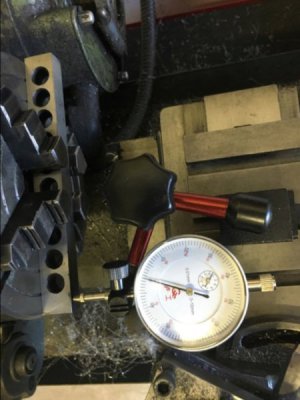- Joined
- Feb 1, 2015
- Messages
- 9,621
My 6" Atlas has flat ways and the surface that controls the perpendicularity of the cross slide to the spindle axis is at the back side and above the apron, in contact with the front vertical surface of the ways. It could be lapped or scraped to correct any non perpendicularity issue. Before doing so, I would confirm that the ways aren't worn and creating the problem. I would also check the carriage gibs and cross slide gibs for proper adjustment.
To measure perpendicularity, I make a skim cut on a flat plate and sweep the surface with a DTI. This will provide a measurable indication of the amount of deviation. I would do this at least at two points along the ways to check for wear in the ways. If you get consistent values at the two points and you have a variation in your sweep readings, there is likely a wear issue with the carriage.
To measure perpendicularity, I make a skim cut on a flat plate and sweep the surface with a DTI. This will provide a measurable indication of the amount of deviation. I would do this at least at two points along the ways to check for wear in the ways. If you get consistent values at the two points and you have a variation in your sweep readings, there is likely a wear issue with the carriage.


